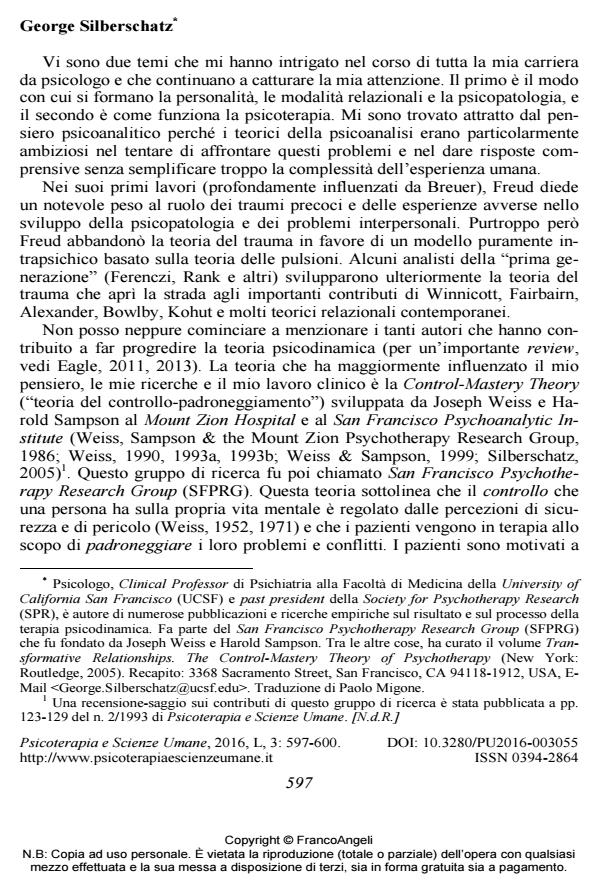Le risposte
Journal title PSICOTERAPIA E SCIENZE UMANE
Author/s George Silberschatz
Publishing Year 2016 Issue 2016/3
Language Italian Pages 4 P. 597-600 File size 30 KB
DOI 10.3280/PU2016-003055
DOI is like a bar code for intellectual property: to have more infomation
click here
Below, you can see the article first page
If you want to buy this article in PDF format, you can do it, following the instructions to buy download credits

FrancoAngeli is member of Publishers International Linking Association, Inc (PILA), a not-for-profit association which run the CrossRef service enabling links to and from online scholarly content.
- Silberschatz G., editor (2005). Transformative Relationships. The Control-Mastery Theory of Psychotherapy. New York: Routledge.
- Silberschatz G. (2015). Improving the yield of psychotherapy research. Psychotherapy Research, in press (pp. 1-13). DOI: 10.1080/10503307.2015.1076202
- Weiss J. (1952). Crying at the happy ending. Psychoanalytic Review, 39, 4: 338.
- Weiss J. (1971). The emergence of new themes: A contribution to the psychoanalytic theory of therapy. International Journal of Psychoanalysis, 52, 4: 459-467.
- Weiss J. (1990). Unconscious mental functioning. Scientific American, 262, 3 (March): 103-109. Internet edition: http://sfprg.org/control_mastery/docs/Weiss1990_2.pdf (trad. it.: I processi mentali dell’inconscio. Le Scienze, 1990, 261, maggio: 68-75).
- Weiss J. (1993a). How Psychotherapy Works. Process and Technique. New York: Guilford (trad. it.: Come funziona la psicoterapia. Presentazione di Paolo Migone e Giovani Liotti. Torino: Bollati Boringhieri, 1999).
- Weiss J. (1993b). A proposito del “San Francisco Psychotherapy Research Group”. Psicoterapia e Scienze Umane, XXVII, 3: 145-147.
- Weiss J., Sampson H. & the Mount Zion Psychotherapy Research Group (1986). The Psychoanalytic Process: Theory, Clinical Observation, and Empirical Research. New York: Guilford (trad. it. del cap. 1: Weiss J., Introduzione al lavoro del “San Francisco Psychotherapy Research Group”. Psicoterapia e Scienze Umane, 1993, XXVII, 2: 47-65).
- Weiss J. & Sampson H., a cura di (1999). Convinzioni patogene. La scuola psicoanalitica di San Francisco (Contributi di Jessica Broitman, Wilma Bucci, Marco Casonato, John T. Curtis, Polly B. Fretter, Harold Sampson, George Silberschatz, Joseph Weiss). Presentazione di Antonio Semerari. Introduzione di Marco Casonato. Urbino: Quattroventi.
- Alexander F., French T.M. et al. (1946). Psychoanalytic Therapy: Principles and Applications. New York: Ronald Press (trad. it. dei capitoli 2, 4 e 17: La esperienza emozionale correttiva. Psicoterapia e Scienze Umane, 1993, XXVII, 2: 85-101. Edizione su Internet: http://www.psychomedia.it/pm/modther/probpsiter/alexan-1.htm).
- Eagle M.N. (1984). Recent Developments in Psychoanalysis. A Critical Evaluation. New York: McGraw-Hill (ristampa: Cambridge, MA: Harvard Univ. Press, 1987) (trad. it.: La psicoanalisi contemporanea. Bari: Laterza, 1988). Edizione su Internet del cap. 11 (ed. or. cap. 12): “Carenze di sviluppo e conflitto dinamico”: www.priory.com/ital/documig8.htm.
- Eagle M.N. (2011). From Classical to Contemporary Psychoanalysis. A Critique and Integration. New York: Routledge (trad. it.: Da Freud alla psicoanalisi contemporanea. Critica e integrazione. Milano: Raffaello Cortina, 2012; trad. it. delle pp. 131-143: La natura sociale della mente. Psicoterapia e Scienze Umane, 2011, XLV, 1: 7-22).
- Eagle M.N. (2013). Attachment and Psychoanalysis. Theory, Research, and Clinical Implications. New York: Guilford (trad. it.: Attaccamento e psicoanalisi. Teoria, ricerca e implicazioni cliniche. Milano: Raffaello Cortina, 2013).
- Gazzillo F. (2016). Fidarsi dei pazienti. Introduzione alla Control-Mastery Theory. Milano: Raffaello Cortina.
- Holt R.R. (1989). Freud Reappraised. A Fresh Look at Psychoanalytic Theory. New York: Guilford (trad. it.: Ripensare Freud. Torino: Bollati Boringhieri, 1994).
- Loewald H.W. (1979). The waning of the Oedipus complex. Journal of the American Psychoanalytic Association, 27, 4: 751-775. DOI: 10.1177/000306517902700401.Anchein:PapersonPsychoanalysis.NewHaven,CT:YaleUniversityPress,1980,pp.384-404(trad
- it.: Il tramonto del complesso di Edipo. In: Riflessioni psicoanalitiche. Milano: Dunod Masson, 1999, cap. 14, pp. 223-241).
- Meisels M. & Shapiro E., editors (1986). Tradition and Innovation in Psychoanalytic Education: Clark Conference on Psychoanalytic Training for Psychologists. Hillsdale, NJ: Erlbaum, 1990 (Convegno organizzato dalla Division 39 [Psychoanalysis] dell’American Psychological Association, Worcester, Massachusetts, October 1986). Internet: http://samples.sainsburysebooks.co.uk/9781134746903_sample_521613.pdf.
- Migone P. & Liotti G. (1998). Psychoanalysis and cognitive-evolutionary psychology: An attempt at integration. International Journal of Psychoanalysis, 79, 6: 1071-1095 (riassunto
- della discussione on-line a cura di Paul Williams: International Journal of Psychoanalysis, 1999, 80, 2: 415-423).
- Rotondo A., a cura di (2000). Joseph Weiss a Milano. In: Quaderni di Psicologia Analisi Transazionale e Scienze Umane, 30.
- Silberschatz G. (1986). Psychology’s contribution to the future of psychoanalysis: A scientific attitude. In: Meisels & Shapiro, 1986, pp. 181-192.
George Silberschatz, Le risposte in "PSICOTERAPIA E SCIENZE UMANE" 3/2016, pp 597-600, DOI: 10.3280/PU2016-003055